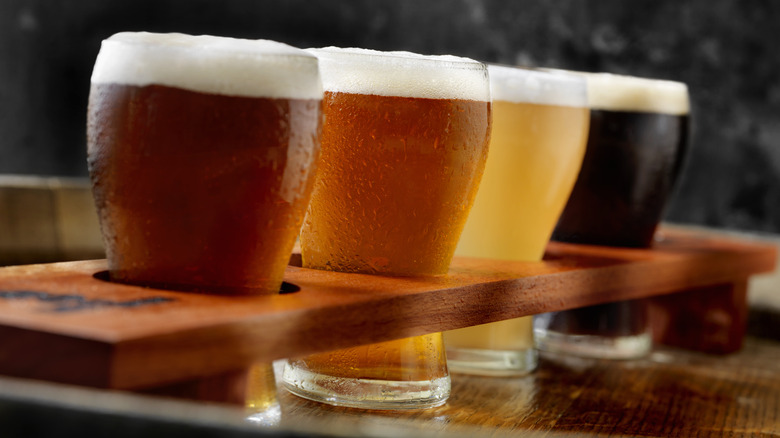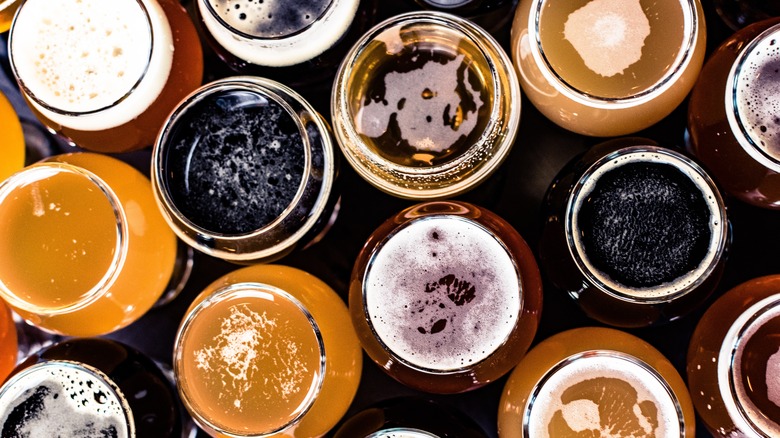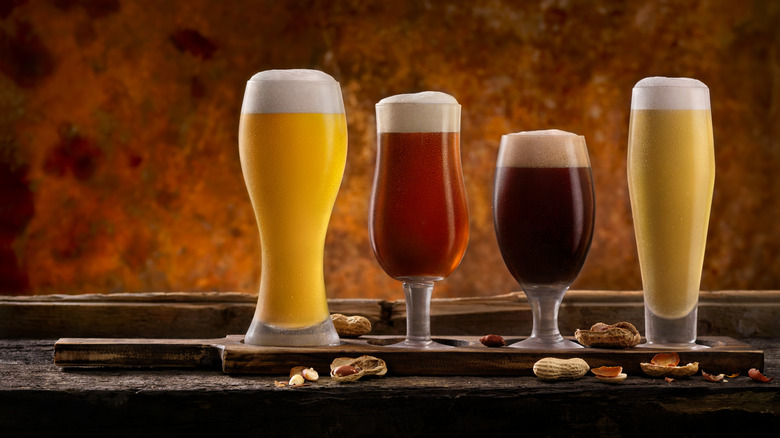Does The Color Of Beer Have Anything To Do With Its Alcohol Content?
Beer comes in a pretty robust variety of shades. Your standard American lagers tend to be a light straw color, while stouts like Guinness can be dark brown or almost black. IPAs commonly vary from pale yellow to deep amber, and black IPAs exist, as well. Red and amber ales are yet more styles you might be familiar with. And that's to say nothing of the literal rainbow of fruit beers you can find at beer bars and bottle shops today. If you're a casual beer drinker trying to parse out what all these different colors indicate, you have a lot of info to sift through.
It wouldn't be unreasonable to guess that the color of a beer signifies its alcohol content — so-called "light" beers are, after all, generally pretty light in color. But while the color of a beer can tell you a couple of things, its alcohol content is not one of them. Beer gets its color from its malt, that being a grain or blend of grains used to brew it. Beer malts are most commonly made of barley, and may also include wheat, rice, sorghum, oats, and others. How darkly the malt is roasted also influences a beer's color.
However, while malt heavily influences the flavor and hue of a beer, it doesn't determine the alcoholic strength. Some of the strongest beers you could ever try are pale in color, and some deep, dark roasts are perfectly casual all-day sippers — and vice versa.
Measuring beer colors
Among brewers and other beer professionals, the color of a beer is labeled by a metric called SRM, or Standard Reference Method. It's essentially a chart that puts numerical values to different beer colors, on a scale ranging from very pale, straw-colored brews to opaque black ones. The SRM can help you guess what a style a beer might be, but color itself doesn't correlate to ABV (alcohol by volume).
Pilsners, for instance, are generally at the lighter end of the spectrum, pouring anywhere from a pale straw color to deep gold, and measuring between roughly 4.5 and 5% ABV on average. But a Belgian Tripel could be a similar gold color and twice as alcoholic. The two styles taste dramatically different because of other ingredients used in the mash, and one will have you flat on your back a lot faster than the other. All that the gold color signifies is that the grains in each beer were about the same tone when they were brewed.
Light versus heavy beers
There's another potentially complicating factor in a beer's hue. When a beer is described as "light" or "heavy," it's often not the color or the alcohol content that's being referred to, but the body. In beverages, the "body" of a drink refers to how it feels in your mouth. There is often some correlation between color and body (also often called "mouthfeel"), with darker beers usually feeling heavier on the palate and more filling in the stomach — but not always.
"Light" can refer to a beer that's light in body, like the sort of easy summer crusher you could drink all day long without feeling bloated. While these kinds of beers are typically lighter in color and lower in alcohol content, those traits don't always overlap. A delicious brown ale, for instance, could be the color of dark coffee, but low in alcohol and light as water to drink. If someone describes a beer as "light," and it isn't clear from the context if they mean that it's light in color, in ABV, or in body, just ask exactly what they mean, or better yet, try the beer in question and see for yourself.


